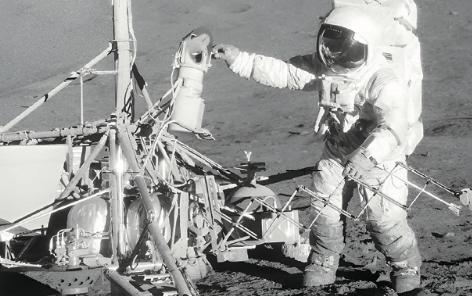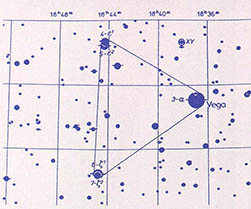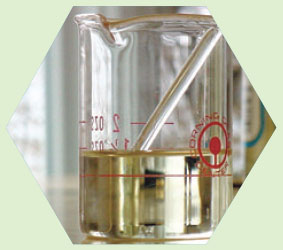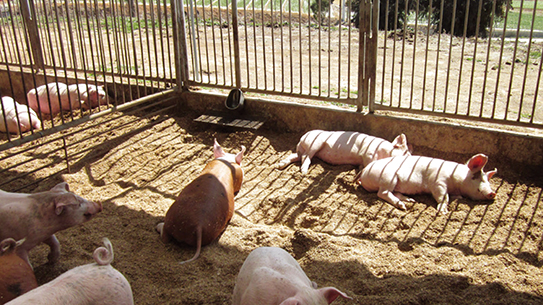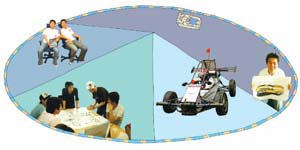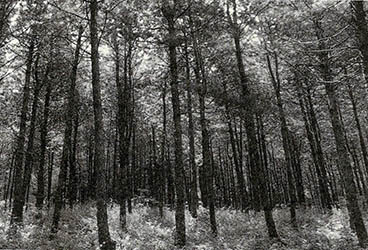
기후학은 중요한 뉴스 거리다. 기후학에서는 빙산의 시료를 통하여 과거를 알아내고, 현재와 더 더워질 미래의 위험에 대하여 연구하고 있다. 필자가 살고 있는 뉴욕에서도 이미 경험된 그 길고도 더운 여름이 사태의 악화를 말해 주는 것이라면 미래는 정말 암울하게 보인다.
심지어 잡지 '자연사'에서는 더워지는 날씨와 이에 대한 동식물들의 다양한 대응방법에 관한 특집을 낼 정도가 되었다. 에어컨이 그대로 사용되고 있는 것에 대하여 비난의 소리가 높아지고 있다. 이것은 미국이 전 지구 대기로 방출되는 이산화탄소의 5분의 1 이상을 방출하여 온실효과를 더 부채질하고 있기 때문이다.
그러나 희망은 있다. 지난 10월, 캘리포니아 모스랜딩 해양연구소의 과학자들은 해양의 특정한 구역에 철성분을 풍부하게 함으로써 미생식물인 조류(藻類)의 수를 증가시킬 수 있는지 여부를 조사한다고 했다.
모스랜딩 연구소의 고(故)존 마틴 박사의 이론에 따르면, 다른 양분은 풍부하지만 철성분이 부족한 바닷물은 철성분이 많은 바닷물보다 생물학적 활성이 좋지 않다고 한다. 마틴 박사의 주장은 광합성에 의하여 늘어난 조류들이 산업사회 초기부터 증가하기 시작한 대기 중 이산화탄소의 탄소 성분을 붙잡아 둔 것이라고 한다.
금성에 있는 이산화탄소는 지속적인 온실효과를 가져왔지만, 적어도 아직까지는 지구에서 그렇지 않다. 생명이 유지될 수 있도록 대기를 균형있게 유지하기 위하여 지구의 생물체는 계속 노력해 왔다. 그러나 이러한 생물체의 자정 현상을 연구하고 있는 과학자들은 이미 상황은 조정불능의 사태로 나아가고 있다고 우려하고 있으며, 마틴의 아이디어를 포함하여 모든 종류의 해결책이 시도되고 있다.
땅을 기본으로 하는 해결책은 나무를 보존하고 더 많이 심는것이다. 그것은 숲이 대기 중의 이산화탄소를 소비하는데 큰 몫을 하기 때문이다. 킹스칼리지의 생물권 과학자인 데이빗 홀에 의하면 숲을 없엠으로써 연간 탄소 20억t이 대기로 방출된다고 한다.
도시에 나무가 잘 심어져 있으면 냉방의 필요성이 좀 줄 것이다. 뉴욕의 도심 거리 주변에 비해 센트럴 파크는 확실히 더 시원하다. 산림기상학자인 고돈 하이슬러에 따르면 집이 나무로 둘러싸여 있을 때 냉방비의 약 10%가 절약될 수 있다고 한다. 시카고 도시·숲·기후 프로젝트의 일원인 하이슬러와 그 동료들은 현재 도시에 있는 나무가 기후와 에너지 소비, 공기의 청정도에 미치는 영향을 연구 중이다.
세계의 모든 과학자들은 여분의 이산화탄소를 처리하기 위하여 아주 기발한 방법들을 생각해내고 있다. 그 중에는 이산화탄소를 폐유전의 밑바닥에 파묻는 일에서부터, 이산화탄소를 얼려 수많은 드라이아이스 볼로 만들어 기화하는데 수백년이 걸리게 하는 방법까지 있다.
이렇게 '탄소를 격리' 시키는 방식을 사용하는 것의 문제점이라면 격리된 이산화탄소가 결국에는 모두 대기 중으로 다시 방출된다는 점이다. 게다가 더 나쁜 점은 폐기처리 기술을 이용하는 것 자체가 추가의 이산화탄소를 만들어내기 때문에 탄소는 처음보다 오히려 많이 대기 중에 방출된다는 것이다.
바다는 이산화탄소를 위한 가장 큰 저장소이므로 지구 온도에 따른 해양의 순환이 집중적으로 연구되고 있다. 월터 문크는 해양음향학을 연구한 공으로 최근 뉴욕 아카데미로부터 회장상을 수상하였다. 그의 연구팀은 해양기후를 위한 음향온도측정(ATOC)을 실험 중이다. 문크는 온실현상도 이같은 방식으로 측정될 것이라고 기대하고 있다.
최근 스위스 과학자는 두개의 같은 온실을 세웠다. 한 온실에는 지금과 같은 양의 이산화탄소를 넣었으며, 다른 하나에는 이산화탄소의 양이 지금과 같은 증가 추세일 때 예상되는 2000년대의 상태로 만들었다. 실험결과 많은 양의 이산화탄소는 토양의 영양분을 소실시켰으며, 식물들은 쉽게 손상을 입게 되었다. 스위스 과학자들에 따르면 온실효과는 식물이 더 자라는 것으로는 상쇄되지 않으며, 아마도 앞으로 식량 생산은 감소될 것이라고 한다.
버지니아대학 스미스와 슈가트가 행한 이전의 연구를 통해 볼때, 증가되는 비율의 이산화탄소를 식물이 더이상 감당하지 못함이 밝혀졌다. 온도가 올라감에 따라 숲은 사라지고, 따라서 그들이 가지고 있던 탄소는 다시 대기 중으로 방출된다. 다른 학자들의 주장에 따르면 북극의 기후가 더워짐에 따라서 더 많은 미생물이 아주 더디게 자라나는 식물을 먹고, 이로 인해서 그 지역의 이탄(泥炭)과 얼어있는 땅은 원래의 양보다 더 많은 양의 이산화탄소를 방출한다고 한다.
당신도 더워지고 있는 것은 느끼는지 모르겠다. 프린스턴 대학, 지구물리 유체역학 연구실의 스토우퍼와 마나베는 더 좋지 않은 소식을 전하고 있다. 그들의 예측에 따르면 이산화탄소의 수준이 지금보다 2배가 되면 지구온난화를 조절하는 북대서양의 능력이 약해진다고 한다. 그런데 만일 그 수준이 예상되는 바와 같이 지금의 4배가 된다면 그 조절 능력은 결코 회복되지 못할 것이라고 한다.
우리가 방출하는 이산화탄소의 양을 지금 줄이지 않는다면, 불행히도 우리를 재난에서 구해줄 해결책은 아무 것도 없을 것이다.
Climatology is big in the news, with research into the past through ice cores, studies of the present and fears of a hotter future. In my part of the planet, New York City, the future looks grim if the long, hot summer we've just had is indicative of worse to come. Natural History Magazine devoted an issue to hot climates and the various ways plants and animals cope. Air conditioners stayed on and guilt went up, for the United States contributes heavily to the greenhouse effect by producing more than one-fifth of all the carbon dioxide emitted into Earth's atmosphere.
There's hope. This October, scientists from Moss Landing Marine Laboratories in California will find out if fertilizing a section of the ocean with iron results in an increase in the numbers of microscopic plants called algae.
According to a theory developed by the late John Martin of Moss Landing, ocean water rich in other nutrients but deficient in iron will not be as biologically active as that with more iron. He suggested that increased numbers of algae might, through photosynthesis, fix more of the carbon in the carbon dioxide that has been increasing in our atmosphere since the start of industrial times.
Carbon dioxide on Venus has created a runaway greenhouse effect, but here on Earth — so far — the planet's living organisms have been struggling to maintain a balanced atmosphere that continues to support life. Scientists studying this phenomenon are worried that things are getting out of hand, so all sorts of solutions are being tried, including Martin's idea.
A land-based solution is to conserve trees and plant more of them, for forests do a great job in using carbon dioxide in the atmosphere. According to biosphere scientist David Hall at Kings College, London, deforestation causes 2 billion tons of carbon to be added to the atmosphere every year.
Cities need less air conditioning when trees are planted — it's noticeably cooler in Central Park than it is a few feet away on the New York City streets. According to forest meteorologist Gordon Heisler, homes save 10 percent in cooling costs when surrounded by trees. Heisler and others are part of the ongoing Chicago Urban Forest Climate Project, studying the effect of urban trees on climate, energy use and air quality.
Scientists all over Earth have been coming up with almost fantastic ways of coping with excess carbon dioxide — from burying it at the bottom of old oil wells to freezing it into enormous balls of "dry ice" that will take hundreds of years to evaporate. The trouble is that all these ways of "carbon sequestration" have an end point that ultimately results in the release of carbon dioxide back into the atmosphere. Even worse, more carbon dioxide will be released than existed in the first place because the disposal engineering techniques themselves produce additional carbon dioxide.
The ocean is the biggest "sink" for carbon dioxide, and its regulation of Earth's temperature is being intensively studied. Walter Munk recently won the Presidential Award from the New York Academy of Scientists for his work in ocean acoustics. He and his colleagues are starting an experiment called ATOC, acoustic thermometry of ocean climate. He hopes to detect greenhouse warming this way.
Swiss scientists recently built two identical greenhouses. In one, the carbon dioxide level was close to that of the present day ; in the other, the level was increased to what it will be in the next century if the present rate of increase of carbon dioxide continues. The experiment showed that the larger amount of carbon dioxide decreased soil nutrients and made plants more susceptible to damage. The Swiss scientists believe that the greenhouse effect cannot be offset by increased plant growth, and that food production will probably decrease.
Thomas M. Smith and Herman H. Shugart, of the University of Virginia in Charlottesville, have also done a study that shows plants cannot manage increasing levels of carbon dioxide. As heat increases, forests die off and release their stored carbon back into the atmosphere. Other researchers claim that peat and Arctic tundra are now giving off more carbon dioxide than they store because the climate is warming up and more microbes eat the vegetation, which grows very slowly.
Are you feeling hotter? More bad news from Syukuro Manabe and Ronald J. Stouffer, of the Geophysical Fluid Dynamics Laboratory/ NOAA Princeton University, New Jersey. Their projections show that although the North Atlantic ocean's ability to manage global warming would be weakened if carbon dioxide levels doubled, it would never recover if the levels were quadrupled — as is expected.
We are, unfortunately, not at all certain that there's any solution to save us from disaster if we don't cut way back on the amount of carbon dioxide we're producing now.
(C) 1993, Los Angeles Times Syndicate





